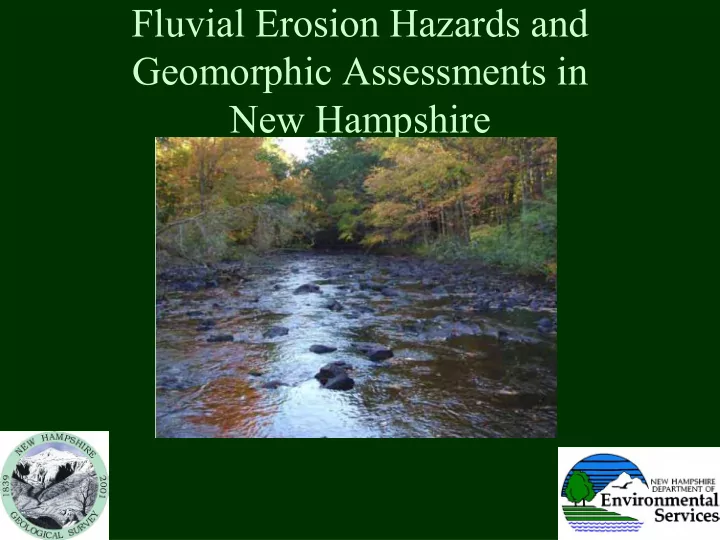

Fluvial Erosion Hazards and Geomorphic Assessments in New Hampshire
What is fluvial geomorphology? Fluvial = action of running water Geomorphology Geo = Earth morph = form ology = study of The study of how running water shapes the landforms on the Earth’s surface.
Connecticut River – northern NH/VT line Lamprey River – southeast New Hampshire
Fluvial Erosion Fluvial erosion = the wearing away of river channel bed and banks by the action of water Is a natural process Typically seen at high flows (bankfull flows) or during flood events, and particularly in reaches that have been altered by human activity or recent natural events.
Erosion on the ground November 2009 March 2010 June 2010
Erosion on the ground 1979 1998 •Stream narrowed by culvert •Velocity increased → erosion downstream of culvert Photos courtesy of Dan Cemerelli, USFS
Fluvial erosion ... and its effects
Piscataquog River Watershed •Major flood events in New Hampshire (20052007) •$75.6 million total inundation and erosion damage •Heavy rains and repetitive rains •New Hampshire’s highest recurring natural hazard risk
New Hampshire Flood Damage $$$$ Since 1978
Can we determine areas that are most susceptible to these kinds of events?
Fluvial Erosion Hazard (FEH) and River Geomorphic Assessments (RGA) Program
New Hampshire’s FEH/RGA Program 2008 Upper and Lower Exeter River Watersheds – Bear Creek Environmental 2009 Ammonoosuc – Field Geology Services Isinglass – New Hampshire Geological Survey Middle Exeter – Bear Creek Environmental Late 2010 2011 Cocheco/Lamprey watersheds, southeast New Hampshire Beyond Piscataquog Souhegan ????
Methods
How can this information be used? • Hazard mitigation plans • The geomorphic condition data will be available in a database for stream restoration activities • Stream restoration and alteration of terrain activities • Prioritization of problematic culverts for rehabilitation or replacement • Watershed management plans • Fluvial Erosion Hazard zoning
Stream restoration activities • Ensure that fluvial geomorphic processes are adequately considered in assessing the longterm sustainability of project benefits. • Essentially, we want to make sure a proposed project or modification to a river doesn’t cause more problems down the road.
We want to work with the river as a system! • With some understanding of how rivers naturally work, we can try to minimize future infrastructure effects by reducing constrictions and disruptions to river process. • Put another way – managing toward rivers that are in balance
2009 & 2010 2008 & 2009
Methods • Phase 1 Stream Geomorphic Assessment • Phase 2 Stream Geomorphic Assessment • Bridge and Culvert Assessment • River Corridor Plan � Stressor Maps � Departure Analysis � FEH zones • Project Identification
Major Stressors: Exeter River • Stormwater inputs from suburban areas • Impacts to riparian buffer • Floodplain encroachment • Undersized & poorly aligned stream crossings • Relict structures • Impoundments (dams) • Agricultural impacts
Localized stormwater outfall erosion
Relic stream ford
Bank failure & buffer encroachment
Dam Impoundments ME07: Phillips Mill Dam ME07: Scribner Road Dam Altered flow regime Flooding & erosion problems
Retrofit Culvert & Plant Trees
Little River, Exeter: Land protection
Projects to Address Stressors • Stormwater management • Conservation and corridor easements • Remove relic structures • Replace/retrofit undersized bridges and culverts • Streambank restoration • Streamside planting • Riparian buffer restoration and protection • Further protect floodplain and floodplain access
Recommend
More recommend